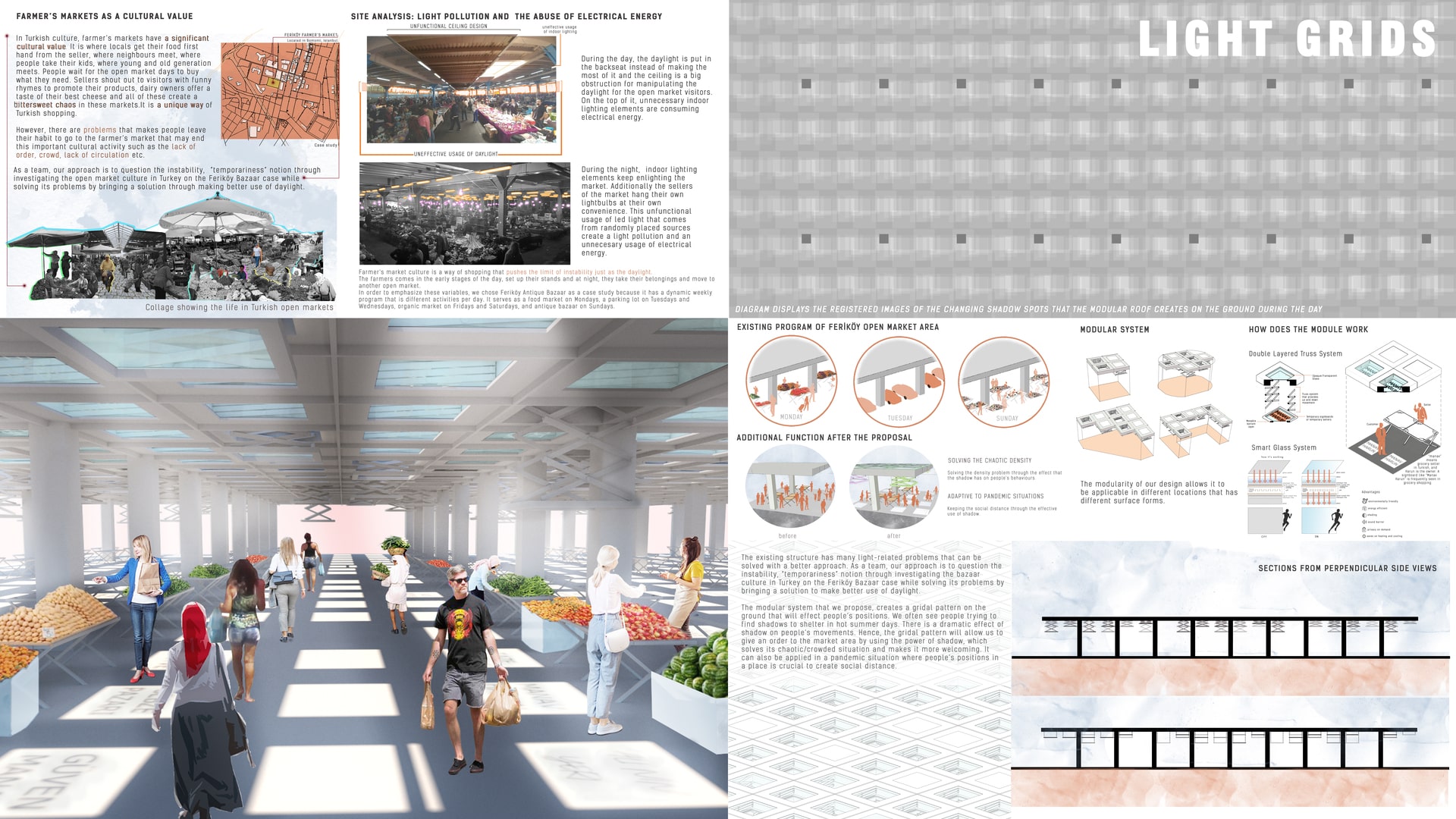Project Description
LIGHT GRIDS Supervisor: Ebru Erbaş Güler Students: Sinem Nazlı Çakıroğlu, Yusufcan Tombaş, Bilge Kobak. Daylight Investigation Category Natural light is a variable that is constantly changing. There are no place in the world that has infinite light or darkness. Our project takes this quality of daylight as its main starting point and connects it with a cultural value; Open Market Activity. In Turkish culture, farmer’s markets have a significant cultural place. It is where locals get their food first hand from the seller, where neighbours meet, where people take their kids, where young and old generation meets. People wait for the open market days to buy what they need. Sellers shout out to visitors with funny rhymes to promote their products, dairy owners offer a taste of their best cheese and all of these create a bitersweet chaos in these markets.It is a unique way of Turkish shopping. However, there are problems that makes people leave their habit to go to the farmer’s market that may end this important cultural activity such as the lack of order, crowd, lack of circulation etc. During these days in a pandemic situation where we question the “normals”, this project aims to reshape the farmer’s market (bazaar) activity which is a big part of the daily life in Turkey while solving the existing problems it had before the pandemi as well. Farmer’s market culture is a way of shopping that pushes the limit of instability just as the daylight. The farmers comes in the early stages of the day, set up their stands and at night, they take their belongings and move to another open market. In order to emphasize these variables, we chose Feriköy Antique Bazaar as a case study because it has a dynamic weekly program that is different activities per day. It serves as a food market on Mondays, a parking lot on Tuesday and Wednesdays, organic market on Fridays and satırdays, and antique bazaar on Sundays. Additionally, the existing structure has many light-related problems that can be solved with a better approach. As a team, our approach is to question the instability, “temporariness” notion through investigating the bazaar culture in Turkey on the Feriköy Bazaar case while solving its problems by bringing a solution to make better use of daylight. In trade, the “permenance” of a place is shown through signboards. It is the basic way of declaring territory. Such as the written details like “since 1965” on them. If this is an indicator of “permenance”, then the lackness of it demonstrates “temporariness”. A seller’s territory in a farmer’s market is a great example of this. Hence, a proposal is made in our project to the case of “being temporary” by taking the dynamism of the daylight taken into consideration. We designed a modular system can be put together in different forms to cover different surfaces in order to offer solutions for the open markets in different locations. The module aims to give an order to the existing area by using the shadow effect and support the temporary activities of the sellers with shadow demonstrations. The module is consist of 2 glass layers, the bottom layer is movable for the users to manipulate the system according to their needs. The sellers can put whatever sign they want to create as a signboard in the form of shadow during the day. With the daylight coming from above, the sign will appear in their stands. This will allow sellers to be able to have a signboard during the day when there is sunlight. And when another seller comes for the next day, s/he can manipulate it according to her/his will. And the temporariness will be used in accordance with the farmer’s market culture. The upper glass layer can turn into an opaque surface when connected to electiricity which allows us to define the places where we want the light comes in and change it according to place’s needs. For example, when it is used as a parking lot, the glass will become opaque and create constant shadow for the parking use. In the market use, the open or close patches can be defined on the roof according to desired light/dark scenerio for the effective use of daylight. The modular system that we propose, creates a gridal pattern on the ground that will effect people’s positions. We often see people trying to find shadows to shelter in hot summer days. There is a dramatic effect of shadow on people’s movements. Hence, the gridal pattern will allow us to give an order to the market area by using the power of shadow, which solves its chaotic/crowded situation and makes it more welcoming. It can also be applied in a pandemic situation where people’s positions in a place is crucial to create social distance.
